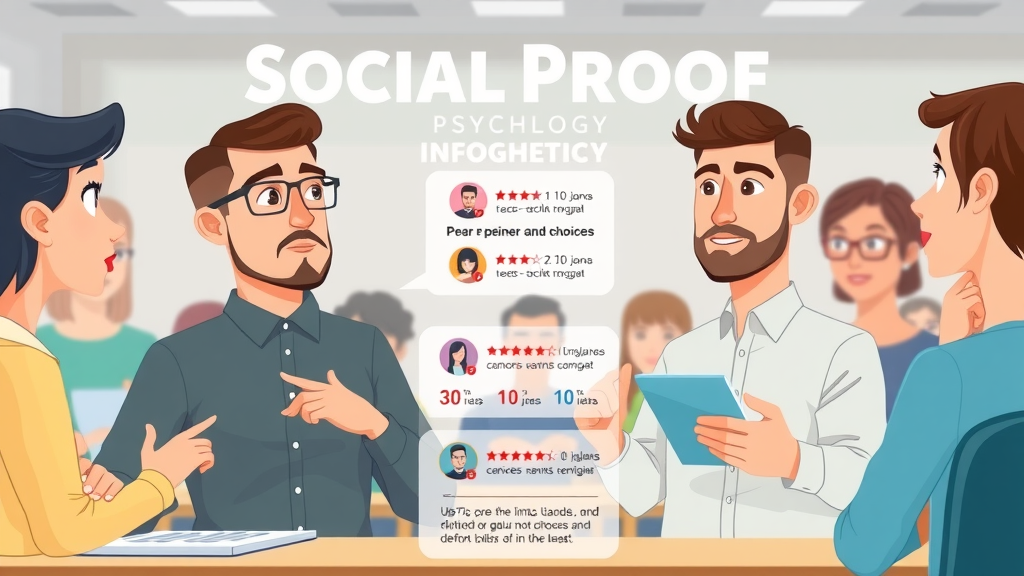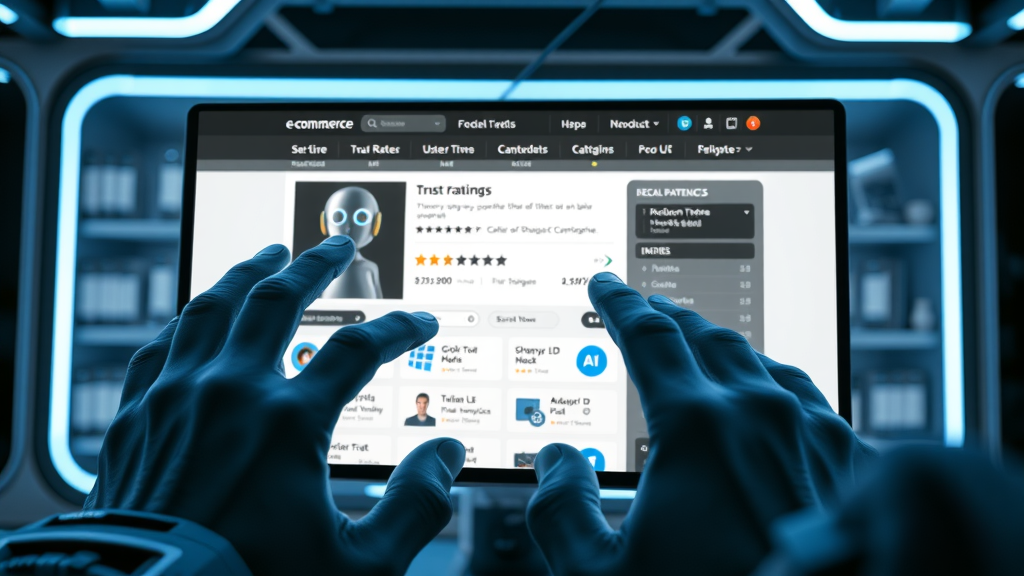Discover How Social Proof Can Skyrocket Your Brand’s Credibility Instantly

- Did you know that 92% of consumers trust social proof , such as recommendations from friends and family, more than advertising? This eye-opening statistic underscores the critical role social proof plays in today's digital landscape. In this comprehensive guide, you’ll learn expert social proof hacks to elevate your trust, visibility, and conversions quickly.
What You Will Gain: Unleashing the Power of Social Proof
- The immediate benefits of implementing social proof, including actionable tactics for social media, product pages, and customer reviews.
- Understanding the core principles and psychological foundations of social proof.
- Top proven strategies and hacks to increase conversions and boost brand credibility overnight.
Understanding Social Proof: Definitions, Psychology, and Impact

What is Social Proof and Why Does It Matter?
- Overview of social proof with definitions and real-world examples: Social proof is a psychological phenomenon where people look to the behaviors and actions of others to determine how they themselves should behave, especially in situations of uncertainty. For example, if you see hundreds of positive customer reviews on a product page, you’re far more likely to trust that product or service yourself. In an age dominated by social networks, the collective opinions and endorsements of others serve as a modern form of social validation, constantly shaping decision making for potential customers and brands alike.

The importance of social proof cannot be overstated. From e-commerce sites leveraging customer testimonials to influencers sharing experiences on social media, every interaction adds to your brand's perceived credibility. For many businesses, especially new entrants, displaying user reviews or gathering authentic customer stories swiftly builds trust and drives engagement. In essence, social proof bridges the trust gap between your solutions and a potential customer’s willingness to buy.
Key Principles of Social Proof According to Robert Cialdini
- Psychological triggers behind social proof: Robert Cialdini, a pioneer in the field of persuasion psychology, highlights social proof as one of the six core principles that drive human behavior. People have a natural impulse to imitate others, especially when the correct behavior is ambiguous. Psychologically, this impulse is rooted in the need for conformity and the desire to make safe decisions based on the collective experience and approval of a group. Businesses using these principles in their landing pages or product pages show significant increases in conversion rates compared to those who neglect social cues.
"People will do things that they see other people are doing" – Robert Cialdini
Social proof works most powerfully when it’s visible, recent, and relevant to your audience. Whether it’s social media shares, badges on landing pages, or customer testimonials on an ecommerce site, leveraging social proof can sway behavior and create a positive association that drives success across every form of digital marketing.
Types of Social Proof and Their Strategic Value
Exploring the Main Types of Social Proof

- Expert social proof : Endorsements or mentions from recognized experts in your industry. For example, a cybersecurity solution highlighted by a reputable tech blog.
- Celebrity endorsements : Popular personalities lending their status to your product or service, amplifying trust among fans.
- User testimonials : Customer reviews and stories directly on your product page or landing pages, showcasing real-word satisfaction.
- Wisdom of the crowd : Displaying metrics like "10,000+ people have purchased" or live purchase feeds, implying broad acceptance.
- Certifications and trust badges : Visual signals such as “Trusted Site”, “SSL Secured”, or third-party accreditations integrated into your checkout process or product pages.
Tables: Side-by-Side Comparison of Types of Social Proof
| Type | Example | Pros | Cons | Best Use Scenario |
|---|---|---|---|---|
| Expert | Industry leader’s testimonial | Builds instant trust | May be less relatable for general public | B2B product pages, professional services |
| Celebrity | Instagram influencer promo | Quickly grabs attention | Can be costly, less authentic | Consumer brands, product launches |
| User Testimonials | Customer reviews on landing pages | Highly relatable, builds trust | Need ongoing collection, moderation | Ecommerce sites, SaaS platforms |
| Wisdom of the Crowd | “10K+ users worldwide” badge | Shows popularity, reduces friction | May seem generic if not specific | Checkout pages, sign-up forms |
| Certifications | Secured/Verified stickers | Demonstrates reliability | May lose effectiveness if overused | Product pages, payment gateways |
Ultimate Social Proof Hacks: Boost Your Credibility Fast
Harnessing Social Media to Maximize Social Proof

- Leveraging shares, likes, user-generated content, and influencer mentions: Social media platforms have become central hubs for powerful social proof. When customers share photos using your products and tag your brand, or when influencers mention your service, the reach is amplified beyond what traditional advertising could accomplish. User-generated content, such as Instagram posts or TikTok videos featuring your offerings, acts as an organic endorsement. Brands that actively encourage tagging, run hashtag campaigns, or highlight customer successes on their feeds enjoy an uptick in trust, bringing more potential customers to their product pages and landing pages.
Furthermore, displaying the number of shares, likes, and testimonials prominently on your own profiles or website can significantly enhance your public perception. As consumers browse social networks, they gravitate toward products with clear, visible support from peers and personalities they admire—making social proof a key driver of discovery, trust, and purchase intent.
Collecting and Showcasing Customer Reviews and Testimonials
- Actionable ways to obtain and publicize authentic reviews and ratings: Actively reach out to satisfied customers and request reviews—via email follow-ups, QR codes, or post-purchase pop-ups. Offer small incentives or loyalty perks to encourage more detailed feedback but never incentivize for anything but honest opinions; authenticity is everything. Display user testimonials across your product pages, landing pages, and dedicated reviews sections, ensuring every prospective buyer sees recent, relevant insights from real people.
Incorporating user reviews and ratings into your site’s visual architecture signals credibility and builds trust instantly. For best results, mix short snippets with in-depth stories, and rotate them regularly so your content stays fresh. High-quality reviews act as both a conversion booster and a search engine optimization asset for your brand, making your offers visible and compelling.
Optimizing Product Pages with Powerful Social Proof Elements

- Integrating badges, star ratings, and real-time purchase activity: Product page layouts that include visible star ratings, trust badges, and purchase notifications turn casual visitors into confident buyers. Solutions like “Verified Buyer” labels or real-time “X people are viewing this product” notifications play on the wisdom of the crowd and urgency to encourage decision making.
Make these forms of social proof unmissable: Above the fold, near call-to-action buttons, or beside product details for maximum impact. By optimizing the structure and placement of these elements on your product pages, you help potential customers see not only what your product or service offers, but why it’s trusted by so many others. Always keep these signals updated with new customer reviews and certifications, as outdated or irrelevant social proof can actually reduce credibility.
Using Customer Testimonials to Build Trust and Influence
- Best practices for gathering, curating, and displaying testimonials: Go beyond star ratings by highlighting diverse stories that represent your full customer base. Use video testimonials or branded spotlight interviews when possible to add an even higher level of authenticity. Regularly request feedback, thank your reviewers, and curate stories that address common objections or showcase key benefits—this adds strategic value to your landing page or about section.
Be transparent and avoid editing customer stories for only positive feedback; honest, balanced testimonials bring out a stronger sense of credibility. Highlight how your business responded to negative user reviews and the improvements made as a result—your willingness to listen and act is also a potent form of social proof. When leveraged correctly, authentic customer testimonials can be your single strongest asset in building long-term trust and a loyal audience.
The Power of Social Proof for Increasing Conversions

How Social Proof Drives Action and Increases Conversions
- Statistics and examples showing conversion improvement with effective social proof: Studies have repeatedly proven that including social proof elements—user reviews, purchase counters, or influencer recommendations—on landing pages or product pages can increase conversions by as much as 34%. Visitors feel reassured when they see others have successfully purchased or positively reviewed the same product or service, removing doubt and accelerating the buying process. A standout example is ecommerce site landing pages with prominent user ratings and testimonials: These consistently outperform those that rely on product descriptions alone.
Social networks and third-party review platforms further amplify this effect. A positive review or shoutout from someone in a potential customer’s network influences decision making more powerfully than most sales copy. As conversion rates rise, business growth follows—proving the unmatched power of social proof for brands seeking to expand their digital footprint quickly and efficiently.
Common Pitfalls to Avoid When Implementing Social Proof
- Overuse, fake testimonials, and outdated content: The benefits of social proof hinge on authenticity, relevance, and timing. Overwhelming your site with repetitive badges or reviews can appear inauthentic and erode trust—especially if visitors suspect your testimonials are fake, outdated, or cherry-picked. Likewise, relying on old customer reviews or social media metrics can make your brand feel stagnant or out of touch. Always update your landing pages and product page sections with the freshest and most honest feedback.
"Social proof works best when it’s timely, relevant, and authentic" – Industry Expert
Avoid copying your competitors’ strategies without personalizing them for your audience. Instead, collect and showcase forms of social proof that are specific to your brand journey, target market, and core values. The right balance and authenticity will keep your conversion rates climbing and your brand’s reputation secure.
Rapid-Action Social Proof Hacks for Every Business Type

-
Instant ideas for e-commerce, SaaS, service providers, and local businesses:
- E-commerce: Add review summaries and photo testimonials to product pages, launch “top seller” badge campaigns, and incentivize unboxing shares on social media.
- SaaS Platforms: Integrate star ratings and case studies from flagship customers, display third-party reviews (like Capterra or G2 badges), and trigger real-time activity feeds (“John from NY just signed up”).
- Service Providers: Use Google and Yelp widgets on your homepage, highlight before-and-after results and success stories, and request LinkedIn recommendations.
- Local Businesses: Feature local awards, community participation, and customer appreciation days; encourage geotagged check-ins and share visitor photos in-store and online.
- How to adapt social proof strategies to your marketing channels and audience: Match the style and placement of social proof to your buyer journey. Younger, social-media-savvy audiences may prefer influencer shoutouts, UGC highlights, and Instagram Stories, while B2B buyers look for expert endorsements and case-study testimonials. Keep each form of social proof timely, and refresh content continuously to maintain engagement across your chosen channels.
Social Proof in Action: Real-World Case Studies and Success Stories
- Brand stories showcasing huge jumps in credibility and conversions: One SaaS startup revamped their landing page to include snippets of user testimonials, reviewer badges, and real-time sign-ups. Their conversion rate doubled overnight—proof of the direct ROI of strategic social proof deployment. Similarly, an online retailer saw a 25% uptick in average order value after including photo reviews and “top rated” labels on hot products.
- Analysis of successful social proof campaigns on social media and product pages: Brands running focused hashtag campaigns (e.g., #MyBrandExperience) gather dozens of organic customer stories, which are then repurposed across their Instagram feeds and landing pages. This not only multiplies positive associations but also provides a reservoir of content that continually builds trust and reinforces brand reputation.
People Also Ask: Answers to Common Social Proof Questions
What is meant by social proof?
- Social proof is the psychological phenomenon where people imitate the actions of others, assuming those actions reflect correct behavior. In practice, it means that when someone sees others endorsing, buying, or reviewing a product or service, they are more likely to follow those behaviors themselves—especially in uncertain situations. This effect is amplified by social networks and online communities, where user reviews and public endorsements are highly visible.
What is an example of social proof?
- A classic example is a customer testimonial on a product page, showing real satisfaction and encouraging trust. Another powerful form is the “most popular” item badge in an e-commerce site’s landing pages, which tells new visitors that a specific product is widely chosen and approved by others. These forms of social proof leverage the concept of collective endorsement to drive more conversions and build trust.
What is social proof in persuasion?
- Social proof in persuasion leverages evidence from other people’s choices or opinions to influence someone’s decision-making. For example, showcasing highly-rated customer reviews or highlighting user-generated content on landing pages can nudge potential customers toward making a purchase by reassuring them through the experiences of previous buyers. The core idea is that people are more likely to be persuaded when they see others undertaking the same actions or holding similar beliefs.
What is the principle of social proof?
- The principle of social proof states that people are likely to adopt behaviors or make purchases when they observe others doing so, especially in uncertain situations. This concept is rooted in conformity and the assumption that the popular or crowd-approved choice represents correct behavior. By showcasing social proof elements on product pages and social networks, brands can capitalize on this principle to build credibility and increase conversions.
Frequently Asked Questions on Social Proof Strategies
- How can I collect more social proof if my business is new? Start by incentivizing early users to leave reviews and share stories about your brand. Offer loyalty perks or public recognition to encourage honest feedback, and showcase every positive mention you receive to build initial momentum.
- What are the most effective social proof types for online businesses? User testimonials, photo reviews, and expert endorsements tend to yield the best results for online businesses. Star ratings and trust badges are also powerful signals on landing page and product page layouts.
- Are there tools to automate social proof collection and display? Yes, platforms like Trustpilot, Yotpo, and Proof can automatically gather and display customer reviews, photo uploads, and live purchase notifications directly on your site for ongoing effectiveness.
- How should I handle negative social proof or poor reviews? Address criticism promptly, with empathy, and showcase your efforts to improve. Transparency in handling feedback builds credibility and can even turn detractors into loyal advocates.
Quick Reference: Social Proof Best Practices Checklist
- Always use genuine and up-to-date social proof.
- Tailor social proof strategies to your audience and platform.
- Encourage customers to leave detailed, honest feedback.
- Display social proof prominently on product pages and social media.
- Monitor and update your social proof elements regularly.
Final Thoughts: Transform Your Credibility Overnight with Social Proof
- Embrace social proof as a powerful, immediate catalyst for trust and conversions.
Sources
- Nielsen – https://www.nielsen.com/us/en/insights/article/2012/consumer-trust-in-online-social-and-mobile-advertising-grows/
- Influence at Work – https://www.influenceatwork.com/principles-of-persuasion/
- HubSpot – https://www.hubspot.com/
- SocialProof.com – https://www.socialproof.com/blog/types-of-social-proof/
To further enhance your understanding of social proof and its impact on marketing strategies, consider exploring the following resources:
-
“What Is Social Proof? Why Is It Essential For Marketing?” This article delves into the significance of social proof in marketing, highlighting how it inspires trust and establishes credibility among consumers. ( wyzowl.com )
-
“Social Proof: Your Secret Weapon for Better Marketing” This piece discusses the integration of social proof with other marketing principles, such as authority and scarcity, to amplify its effectiveness in influencing consumer behavior. ( fomo.com )
If you’re serious about leveraging social proof to boost your brand’s credibility and conversions, these resources will provide you with valuable insights and actionable strategies.
 Add Row
Add Row  Add
Add 




Write A Comment